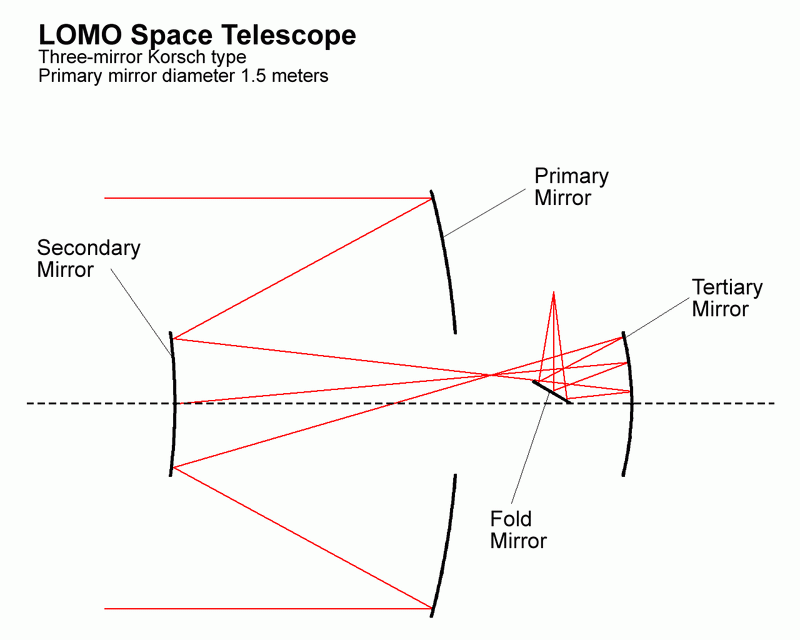.gif)
Persona (satellite)
Encyclopedia
Persona is a class of Russia
n reconnaissance satellites, derived from the Resurs DK
class of remote sensing satellite, itself derived from the Soviet Yantar reconnaissance satellites. The satellites are built by TsSKB Progress, and the optics by LOMO
and the Vavilov State Optical Institute.
The first satellite, identified as Kosmos 2441, was launched into a 750 km sun synchronous orbit on 26 July 2008, atop a Soyuz-2.1b
carrier rocket from LC-43/4 at the Plesetsk Cosmodrome
It reportedly failed to return useful imagery due to an electrical malfunction.
The satellites have a mass of 6500 kilograms (14,330 lb), are 7 metres (23 ft) long, and 2.7 metres (8.9 ft) in diameter.
 The satellites optical subsystems are believed to be based on a 3-mirror Korsch type telescope with a primary mirror diameter of 1.5 metres (4.9 ft) and focal length of 20 metres (65.6 ft).
The satellites optical subsystems are believed to be based on a 3-mirror Korsch type telescope with a primary mirror diameter of 1.5 metres (4.9 ft) and focal length of 20 metres (65.6 ft).
The CCD sensor is probably ELCT1080v1U with a pixel size of 9 µm. The CCD is produced by ELAR, previously known as ELECTRON-OPTRONIC.
The focal plane unit is manufactured by NPO Opteks.
The satellites have a nadir
image resolution of 33 centimetres (13 in), using panchromatic
imagery. They are planned to operate for 7 years.
Russia
Russia or , officially known as both Russia and the Russian Federation , is a country in northern Eurasia. It is a federal semi-presidential republic, comprising 83 federal subjects...
n reconnaissance satellites, derived from the Resurs DK
Resurs DK
Resurs-DK1 is a commercial Earth observation satellite capable of transmitting high-resolution imagery to the ground stations as it passes overhead...
class of remote sensing satellite, itself derived from the Soviet Yantar reconnaissance satellites. The satellites are built by TsSKB Progress, and the optics by LOMO
LOMO
LOMO or Leningrad Optical Mechanical Amalgamation is a manufacturer of advanced optical instruments, medical equipment, consumer still and movie cameras, projectors, lenses, film editors, splicers, professional sound recorders for motion-picture production based in St. Petersburg, Russia...
and the Vavilov State Optical Institute.
The first satellite, identified as Kosmos 2441, was launched into a 750 km sun synchronous orbit on 26 July 2008, atop a Soyuz-2.1b
Soyuz 2 rocket
Soyuz-2, GRAU index 14A14, is the collective designation for the new version of the Russian Soyuz rocket. In its basic form, it is a three-stage carrier rocket for placing payloads into low Earth orbit. The first stage boosters and two core stages feature uprated engines with improved injection...
carrier rocket from LC-43/4 at the Plesetsk Cosmodrome
Plesetsk Cosmodrome
Plesetsk Cosmodrome is a Russian spaceport, located in Arkhangelsk Oblast, about 800 km north of Moscow and approximately 200 km south of Arkhangelsk.-Overview:...
It reportedly failed to return useful imagery due to an electrical malfunction.
The satellites have a mass of 6500 kilograms (14,330 lb), are 7 metres (23 ft) long, and 2.7 metres (8.9 ft) in diameter.

The CCD sensor is probably ELCT1080v1U with a pixel size of 9 µm. The CCD is produced by ELAR, previously known as ELECTRON-OPTRONIC.
The focal plane unit is manufactured by NPO Opteks.
The satellites have a nadir
Nadir
The nadir is the direction pointing directly below a particular location; that is, it is one of two vertical directions at a specified location, orthogonal to a horizontal flat surface there. Since the concept of being below is itself somewhat vague, scientists define the nadir in more rigorous...
image resolution of 33 centimetres (13 in), using panchromatic
Panchromatic
Panchromatic film is a type of black-and-white photographic film that is sensitive to all wavelengths of visible light. A panchromatic film therefore produces a realistic reproduction of a scene as it appears to the human eye. Almost all modern photographic film is panchromatic, but some types are...
imagery. They are planned to operate for 7 years.

